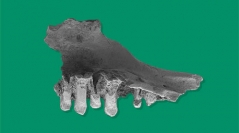

 Comptes Rendus Palevol
22 (18) - Pages 409-438
Comptes Rendus Palevol
22 (18) - Pages 409-438The Columbretes Islands (eastern Spain) comprise a volcanic archipelago 50 km off the eastern Spanish coast. Illa Grossa is the main island of the archipelago. After the settlement of humans during the mid-19th century, strong modifications in biodiversity took place, including the reduction of the non-flying vertebrate fauna to a single taxon, Podarcis liolepis atratus (Boscá, 1916). The study of the fossils yielded at the COLT site (dated by AMC between 2780-2724 cal BP and 2600-2492 cal BP) from a loess deposit located at the south of Illa Grossa Island shows that this fauna was more diverse in the past. The assemblage was dominated by squamate reptiles, belonging to two lizards (Chalcides bedriagai (Boscá, 1880) and cf. Podarcis Wagler, 1830) and one snake (Vipera cf. latastei Boscá, 1878). The record in the late Holocene of Columbretes of Vipera cf. latastei settles the existing controversy about the identity of snakes in the archipelago. Regarding Chalcides bedriagai, this is the first record of its presence in the Columbretes Islands. Other faunal elements recovered from the site include at least six species of undetermined birds (passeriforms and procellariforms) and the anthropophilic Mus cf. musculus Linnaeus, 1758. The origin of the squamates taxa from Columbretes palaeontological site (COLT) is still unclear, but was probably related to the Late Pleistocene-Greenlandian (11 700 to 8300 BP, Early Holocene) sea transgression, natural passive colonization, and/or human introduction. We hypothesize implications for the conservation and management of the Natural Reserve.
Vipers, conservation palaeobiology, small vertebrates, Mediterranean, palaeoecology, islets